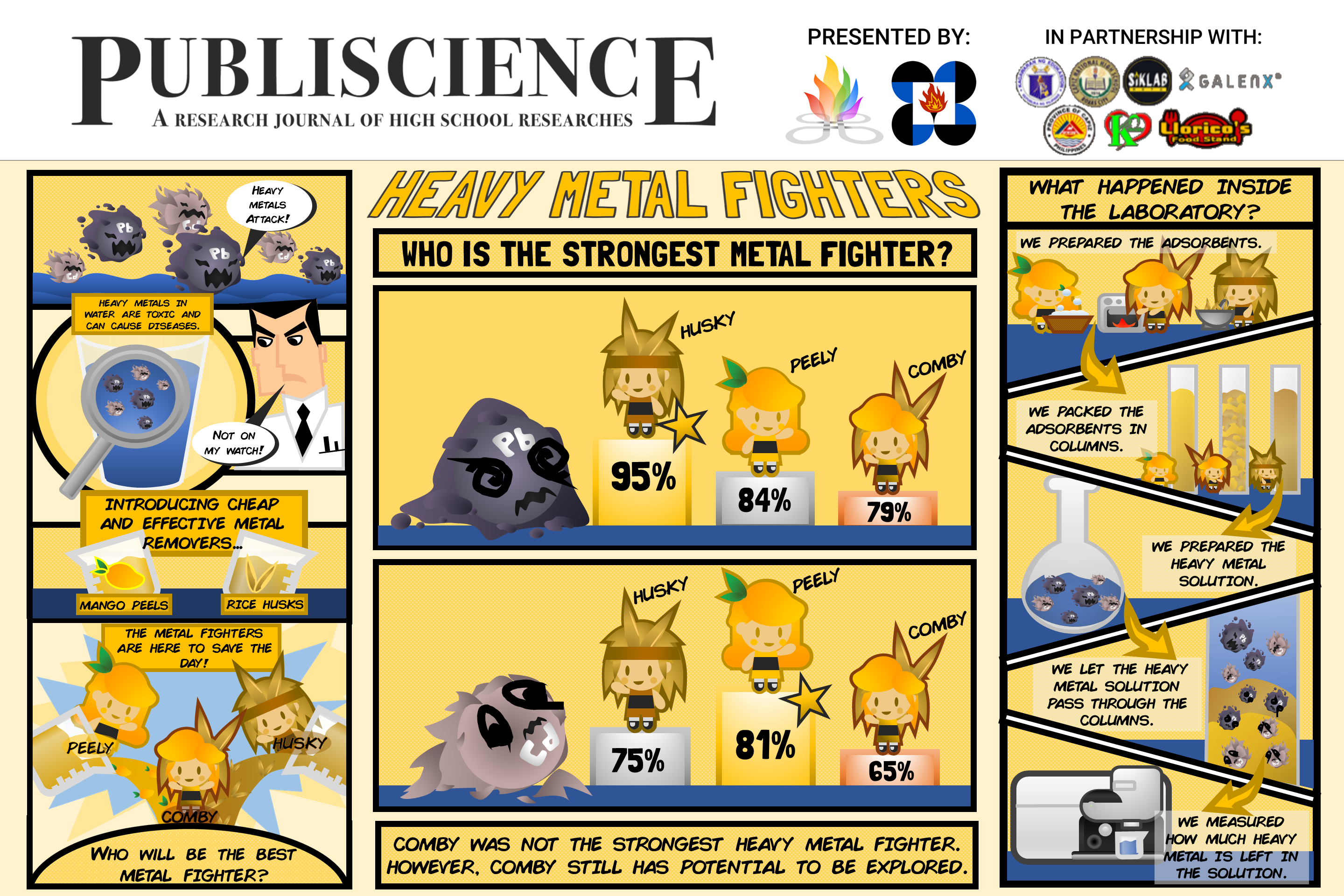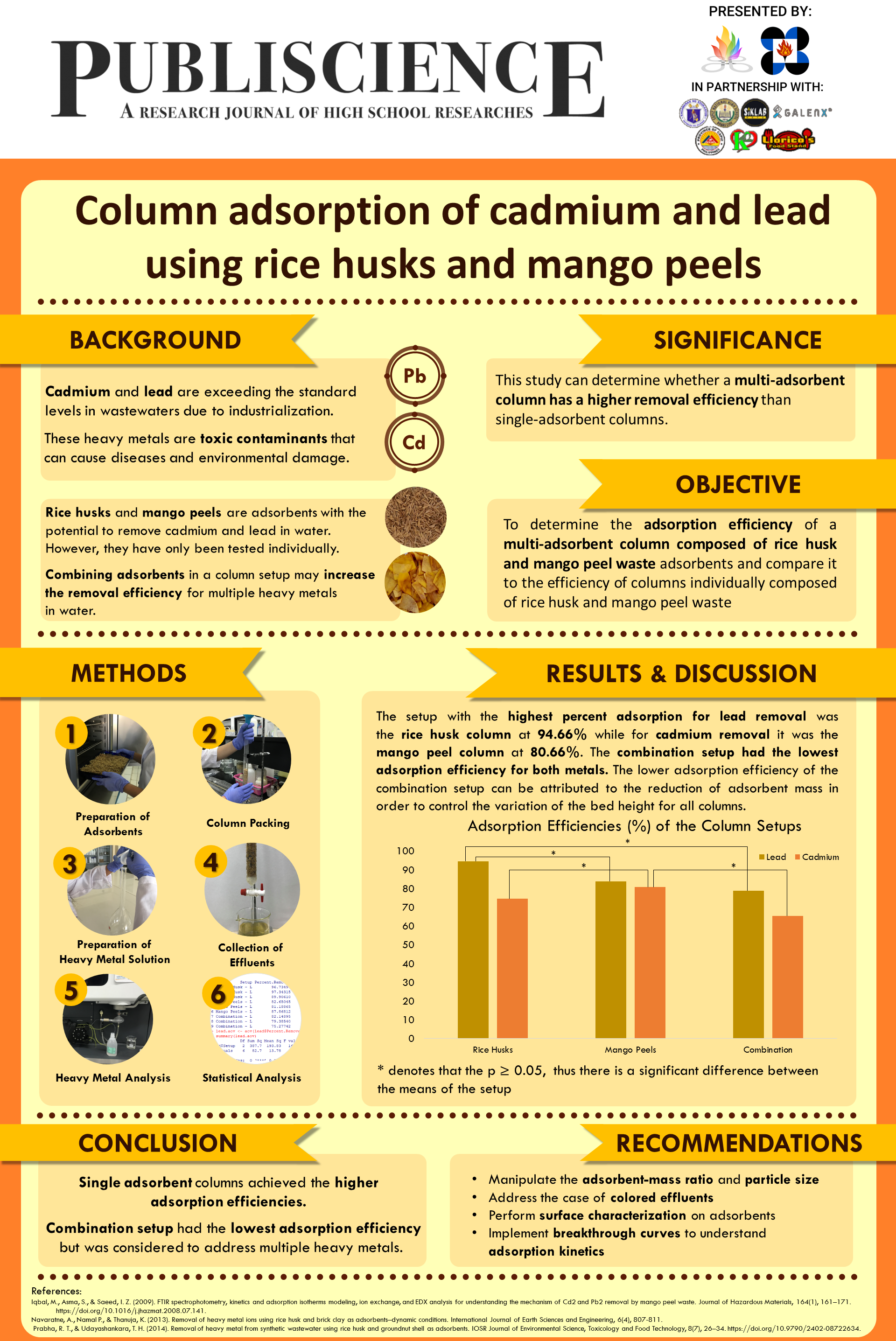Column adsorption of cadmium (II) and lead (II) using rice husks and mango peels
KATRINA BIANCA T. BANDIOLA, JOSUA JAMES ANGELO Y. GALOTERA, JENN CHRISTEL C. SAMPIANO, and HAROLD P. MEDIODIA
Philippine Science High School – Western Visayas Campus, Brgy. Bito-on, Jaro, Iloilo City 5000, Department of Science and Technology, Philippines
Abstract
Cadmium(II) and lead(II) are commonly found in industrial wastewaters and have negative effects to the body and the environment with prolonged exposure. Conventional methods to remove these metals are costly and inefficient. An alternative method that is more economical is through adsorption, specifically through the use of fruit and vegetable peels. The adsorption efficiencies of a multi-adsorbent column setup composed of rice husk and mango peels, and single-adsorbent columns individually composed of rice husk and mango peels were determined and compared in the removal of cadmium and lead. The heavy metal solution with an initial concentration of 10 mg/L and 30 mg/L for lead and cadmium, respectively, and a pH of 6.0, was tested on the adsorbent column with a bed height of 15cm and a flow rate of ~10mL/min. It was determined that the combination setup had the lowest adsorption efficiency out of all three setups. This was attributed to a reduction on the masses of the adsorbents to control the bed height variable. The single adsorbent column achieved the higher adsorption efficiency with rice husk at 94.661% for lead and the mango peel column at 80.860% for cadmium.
Keywords: bed height, column adsorption, heavy metals, multi-adsorbent setup, agricultural wastes
References:
- Li Y, Zhou Q, Ren B, Luo J, Yuan J, Ding X, … & Yao X. 2020. Trends and health risks of dissolved heavy metal pollution in global river and lake water from 1970 to 2017. Rev Environ Contam T. 251(2020): 1-24.
- Iqbal M, Saeed A, Zafar SI. 2009b. FTIR spectrophotometry, kinetics and adsorption isotherms modeling, ion exchange, and EDXanalysis for understanding the mechanism of Cd(2+) and Pb(2+) removal by mango peel waste. J Hazard Mater. 164(1): 161-71.
- Vera LM, Bermejo D, Uguña MF, Garcia N, Flores M, González E. 2019. Fixed bed column modeling of lead (II) and cadmium (II) ions biosorption on sugarcane bagasse. Environ Eng Res. 24(1): 31-37.
- Sarinas B, Gellada L, Jamolangue E, Teruñez M, Flores J. 2014. Assessment of heavy metals in sediments of Iloilo Batiano River, Philippines. IJESD. 5(6): 543-546.
- Prabha RT, Udayashankara TH. 2014. Removal of heavy metal from synthetic wastewater using rice husk and groundnut shell as adsorbents. IOSR-JESTFT. 7(11): 26-34.
- Iqbal M, Saeed A, Kalim I. 2009a. Characterization of adsorptive capacity and investigation of mechanism of Cu2+, Ni2+, and Zn2+ adsorption on mango peel waste from constituted metal solution and genuine electroplating effluent. Sep Sci Technol. 44(2009): 3770–3791.
- Romero-Cano LA, González-Gutiérrez LV, Baldenegro-Pérez LA, Carrasco-Marín F. 2017. Grapefruit peels as biosorbent: characterization and use in batch and fixed bed column for Cu(II) uptake from wastewater. J Chem Tech Biotech. 92(7): 1650–1658.
- Navaratne A, Priyantha N, Kulasooriya TPK. 2013. Removal of heavy metal ions using rice husk and brick clay as adsorbents–dynamic conditions. Int J Earth Sci Eng. 6(4): 807-811.
- Binabaj MA, Nowee SM, Ramezanian N. 2017. Comparative study on adsorption of chromium(VI) from industrial wastewater onto nature-derived adsorbents (brown coal and zeolite). Int J Environ Sci Tech. 15(7): 1509–1520.
- Sadon FN, Ibrahem AS, Ismail KN. 2014. Comparative study of single and multi-layered fixed bed columns for the removal of multimetal element using rice husk adsorbents. J App Sci. 14(2014): 1234-1243.
- Ashraf MA, Mahmood K, Wajid A. 2011. Study of low cost biosorbent for biosorption of heavy metals. IPCBEE. 9(2011): 60-69.
- Amarasinghe BMWPK. 2011. Lead and cadmium removal from aqueous medium using coir pith as adsorbent: batch and fixed bed column studies. JTFE. 1(2011): 36-47.
- Jena S, Sahoo RK. 2017. Removal of Pb(II) from aqueous solution using fruits peel as a low cost adsorbent. Int J Adv Res Sci Eng Technol. 5(1): 5-13.
- Amin MT, Alazba AA, Shafiq M. 2017. Batch and fixed-bed column studies for the biosorption of Cu(II) and Pb(II) by raw and treated date palm leaves and orange peel. Global NEST J. 19(3): 464-478.
- Nambi VE, Thangavel K, Jesudas DM. 2015. Scientific classification of ripening period and development of colour grade chart for Indian mangoes (Mangifera indica L.) using multivariate cluster analysis. Scientia Horticulturae. 193(2015): 90-98.


